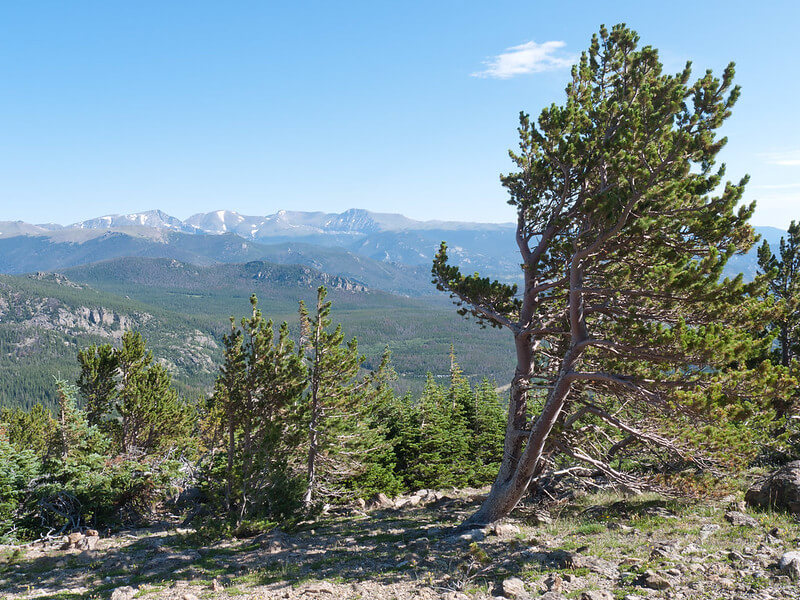Wondering About Wind
By Lisa Bickell
Broadcast 7.5 & 7.8.2023

The fierce winds of the high mountains alter the trees that live there. Photo by Jesse Varner, CC by-NC-SA 2.0.
Listen:
In July I hiked Ch-paa-qn Peak with my family. Its Salish name, “Shining Peak,” is fitting as the highest point in the Ninemile Ranger District, just outside of Missoula, Montana.
The trail starts already high at 6,200 feet. It climbs steadily through high-elevation spruce and subalpine fir to the final, challenging pitch, a talus field with massive boulders.
Here above the tree line, the wind hits us. As we scramble up the mountainside, we pull out all the clothing layers we bothered to pack. At the summit, the 360-degree panorama is supposed to be breathtaking, but I barely remember it. Once we were exposed at 7,996 feet, the wind that day was unbearable. The summer sun’s warmth was blown away by a wind chill that left my hands clenched in fists. We took refuge behind a stone wall stacked by hikers before us.
Wind has a way of blowing in and cutting short an adventure. It can ruin a picnic. It can wreak havoc on the best-laid plans. At its worst, it can be dangerous and even deadly. But it also creates the breeze that shakes the leaves of quaking aspen. It carries the seeds of black cottonwood and the wings of Red-tailed Hawks to new destinations.
So, what causes wind? And what makes it so wild?
Wind is, simply, moving air or other gasses, relative to the earth’s surface.
The earth is not flat or smooth. It is covered in the textures of land and water. Earth is also constantly spinning on its axis, with half the planet lit by the sun while the other half lies in darkness. The sun heats the earth in different places at different times, creating a patchwork of temperatures across the surface. Mountains, oceans, lakes, trees, and even the cities we’ve built affect how the earth heats and cools with respect to the sun.
When the sun warms a place on Earth, the air in that spot heats up, and the atmosphere heats up, too. The atoms and molecules in the atmosphere begin to move faster and faster. They spread out and rise. When warm air rises, it leaves behind an area of low pressure.
On the other hand, the molecules in cool air are more tightly packed together and will sink downward, creating force and causing high pressure.
Air naturally flows from areas of high pressure to areas of low pressure. The air from the cooler, high-pressure area will flow to the space left by the warmer, low-pressure area. The bigger the pressure difference, and the greater the temperature difference, between these zones, the faster the air will move.
We experience that moving air as wind.
So why is it so windy on top of a mountain like Ch-paa-qn? One reason is that when we climb above the treeline, there are no trees or buildings, and even fewer mountains to slow and restrict the force of the wind. Surrounded by unimpeded air, we’re more likely to experience high winds.
After a few quick wind-blown photos on top of Ch-paa-qn, we made our escape, grateful to feel the wind speed dissipate as we dropped back down to the treeline. Descending into the shelter of the tree-lined trail, we packed away our windbreakers, and the gusts from the summit were all but forgotten. The breeze in the forest was gentle and kind.
Every week since 1991, Field Notes has inquired about Montana’s natural history. Field Notes are written by naturalists, students, and listeners about the puzzle-tree bark, eagle talons, woolly aphids, and giant puffballs of Western, Central and Southwestern Montana and aired weekly on Montana Public Radio.
Click here to read and listen to more Field Notes. Field Notes is available as a podcast! Subscribe on Apple Podcasts or wherever you listen to podcasts.
Interested in writing a Field Note? Contact Allison De Jong, Field Notes editor, at adejong [at] montananaturalist [dot] org or 406.327.0405.
Want to learn more about our programs as well as fun natural history facts and seasonal phenology? Sign up for our e-newsletter! You can also become a member and get discounts on our programs as well as free reciprocal admission to 300+ science centers in North America!












